Digital Photography Tips For Beginners: Grasping Your Camera In A Snap
Digital Photography Tips For Beginners: Grasping Your Camera In A Snap
Blog Article
Content Author-Lyons Turan
When you first get your cam, it can really feel overwhelming with all the settings and options readily available. You may find yourself questioning exactly how to navigate aperture, shutter speed, and ISO efficiently. Understanding these fundamentals is critical, but there's more to digital photography than simply technical knowledge. Recognizing composition strategies and illumination conditions can elevate your pictures dramatically. So, what if you could learn easy approaches to enhance your abilities and begin recording remarkable photos quicker than you believe? Allow's check out how to transform your digital photography trip.
Understanding Electronic Camera Setups
Understanding your electronic camera setups is vital for catching magnificent pictures. When you grab your electronic camera, familiarize on your own with the 3 major settings: aperture, shutter speed, and ISO. Each plays a crucial role in how your photos turn out.
Beginning with aperture, which controls the amount of light getting in the lens. A broader aperture (reduced f-number) lets in a lot more light and develops a beautiful history blur, ideal for pictures. On the other hand, a narrower aperture (greater f-number) maintains even more of the scene in focus, perfect for landscapes.
Next off, concentrate on shutter speed. This setup figures out for how long your video camera's sensor is revealed to light. A rapid shutter speed ices up activity, which is wonderful for activity shots, while a sluggish shutter speed can develop stunning impacts like smooth water in landscapes.
Finally, change your ISO. This setup impacts your video camera's level of sensitivity to light. A greater ISO serves in low-light circumstances but can present noise or grain. Aim for the lowest ISO feasible while still accomplishing appropriate direct exposure.
Make-up Strategies
When you're out shooting, structure can make all the distinction in just how your images reverberate with visitors. Begin by utilizing the regulation of thirds; envision your frame split into 9 equivalent sections with 2 horizontal and 2 vertical lines. Position key elements along these lines or at their junctions to develop equilibrium and passion.
Next off, think about leading lines. These all-natural lines in your scene, like roadways or rivers, draw the audience's eye right into the photograph, guiding them through the story you're telling.
Don't forget about mounting; use aspects within your scene, like trees or windows, to create a frame around your topic, including depth and focus.
Likewise, watch on https://blogfreely.net/dannie530julianne/typical-blunders-new-photographers-make-and-exactly-how-to-stay-clear-of-them . A messy history can sidetrack from your main subject, while a straightforward one helps it stick out.
Lastly, try out balance and patterns; they can create a striking picture that records interest.
Learning Illumination Conditions
Grasping illumination conditions is crucial for catching spectacular pictures, as the appropriate light can transform a regular scene into something amazing.
Beginning by observing natural light at different times of the day. Early mornings and late afternoons provide the best light, called the golden hour. The soft, warm tones throughout these times can improve your images beautifully.
Do not avoid overcast days either; diffused light can decrease extreme shadows and develop a pleasing impact, especially for portraits.
Explore backlighting by positioning your subject versus the source of light. This technique can produce a wonderful halo result and add depth to your images.
Take note of your cam setups as well. Change the ISO, aperture, and shutter speed to match the illumination problems. A greater ISO can help in reduced light, but be cautious of grain.
Use a tripod in darker environments to stay clear of blur.
Finally, do not fail to remember artificial lights. Flash and constant lights can be wonderful tools for controlling light in challenging problems.
Conclusion
To conclude, understanding your cam doesn't need to be overwhelming. By recognizing your settings, using composition strategies, and taking advantage of the power of natural light, you'll swiftly boost your photography skills. Bear in mind, exercise makes excellent, so go out there and explore your newfound expertise. With https://petapixel.com/2018/08/02/5-wedding-photography-tips-for-those-getting-started-in-the-industry/ and commitment, you'll be capturing magnificent photos that mirror your distinct viewpoint. Appreciate the trip, and don't fail to remember to have fun while you're at it!
